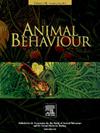抗捕食者综合症:蝌蚪的行为、形态和生活史可塑性建模和测试
IF 2.3
2区 生物学
Q2 BEHAVIORAL SCIENCES
引用次数: 0
摘要
蝌蚪表现出各种行为、形态和生活史上的适应,以逃避捕食者或逃避它们的攻击。这些特征是昂贵的,它们的表达涉及权衡,导致可预测的表型整合模式。在个体内部,这些模式源于对外部因素(如捕食风险)的可塑性调整。相反,在个体之间,它们反映了外在因素和内在因素的差异,例如资源可用性或遗传质量。在这里,我们测试了一个假设,即这些整合模式,无论是在个体内部还是在个体之间,都直接取决于蝌蚪如何管理它们的能量预算。我们的方法既是理论的也是实证的。我们创建了蝌蚪生活史的最优模型。这个模型检查了两个关键参数:进食时间,这决定了蝌蚪的每日能量预算和遇到捕食者的概率,以及分配给发展防御特征的每日能量预算的部分。虽然这种分布增加了躲避捕食者攻击的可能性,但也降低了生长发育速度。该模型还考虑了个体间差异的两种模式:代谢效率和代谢能力的差异。从这个模型中,我们得出了个体内部和个体之间性状共变的预测。为了验证这些预测,我们用棕蛙(Rana dalmatina)的蝌蚪做了一个实验。我们在有或没有捕食者的环境中饲养它们的兄弟姐妹,并在有或没有捕食者的环境中反复对它们进行测试。我们观察到理论和实证结果在个人层面上的一致关系。与捕食者一起长大的蝌蚪表现出活动减少,发展出更大的防御特征(如更深的尾巴和更快的运动),比对照组的兄弟姐妹生长更慢,需要更长的时间才能变形。在这两种个体发生处理中,观察到的个体间共变模式支持了蝌蚪代谢效率而非代谢能力差异的观点。本文章由计算机程序翻译,如有差异,请以英文原文为准。
Antipredator syndrome: modelling and testing behavioural, morphological and life history plasticity in tadpoles
Tadpoles show various behavioural, morphological and life-history adaptations to evade predators or escape their attacks. These traits are costly and their expression involves trade-offs, resulting in predictable patterns of phenotypic integration. Within individuals, these patterns arise from plastic adjustments in traits in response to extrinsic factors, such as predation risk. In contrast, among individuals, they reflect differences in both extrinsic and intrinsic factors, such as resource availability or genetic quality. Here, we tested the hypothesis that these patterns of integration, both within and among individuals, directly depend on how tadpoles manage their energy budgets. Our approach was both theoretical and empirical. We created an optimality model for tadpole life history. This model examined two key parameters: the time spent feeding, which determined both the tadpole’s daily energy budget and the probability of encountering predators, and the portion of the daily energy budget allocated to developing defensive traits. While this distribution increased the likelihood of avoiding predator attacks, it also decreased growth and development rates. The model also considered two patterns of among-individual variation: variation in metabolic efficiency and metabolic capacity. From this model, we derived predictions about trait covariation within and among individuals. To test these predictions, we conducted an experiment using tadpoles of the brown frog, Rana dalmatina. We raised siblings either in the presence or absence of predators, and we repeatedly tested them in arenas both with and without caged predators. We observed a consistent relationship between theoretical and empirical findings at the individual level. Tadpoles that were raised with predators showed reduced activity, developed larger defensive traits (such as deeper tails and faster movements), grew more slowly and took longer to metamorphose than their control siblings. In both ontogenetic treatments, the observed among-individual covariation pattern supported the idea that tadpoles differed in metabolic efficiency rather than metabolic capacity.
求助全文
通过发布文献求助,成功后即可免费获取论文全文。
去求助
来源期刊

Animal Behaviour
生物-动物学
CiteScore
4.60
自引率
8.00%
发文量
236
审稿时长
10.2 weeks
期刊介绍:
Growing interest in behavioural biology and the international reputation of Animal Behaviour prompted an expansion to monthly publication in 1989. Animal Behaviour continues to be the journal of choice for biologists, ethologists, psychologists, physiologists, and veterinarians with an interest in the subject.
 求助内容:
求助内容: 应助结果提醒方式:
应助结果提醒方式:


